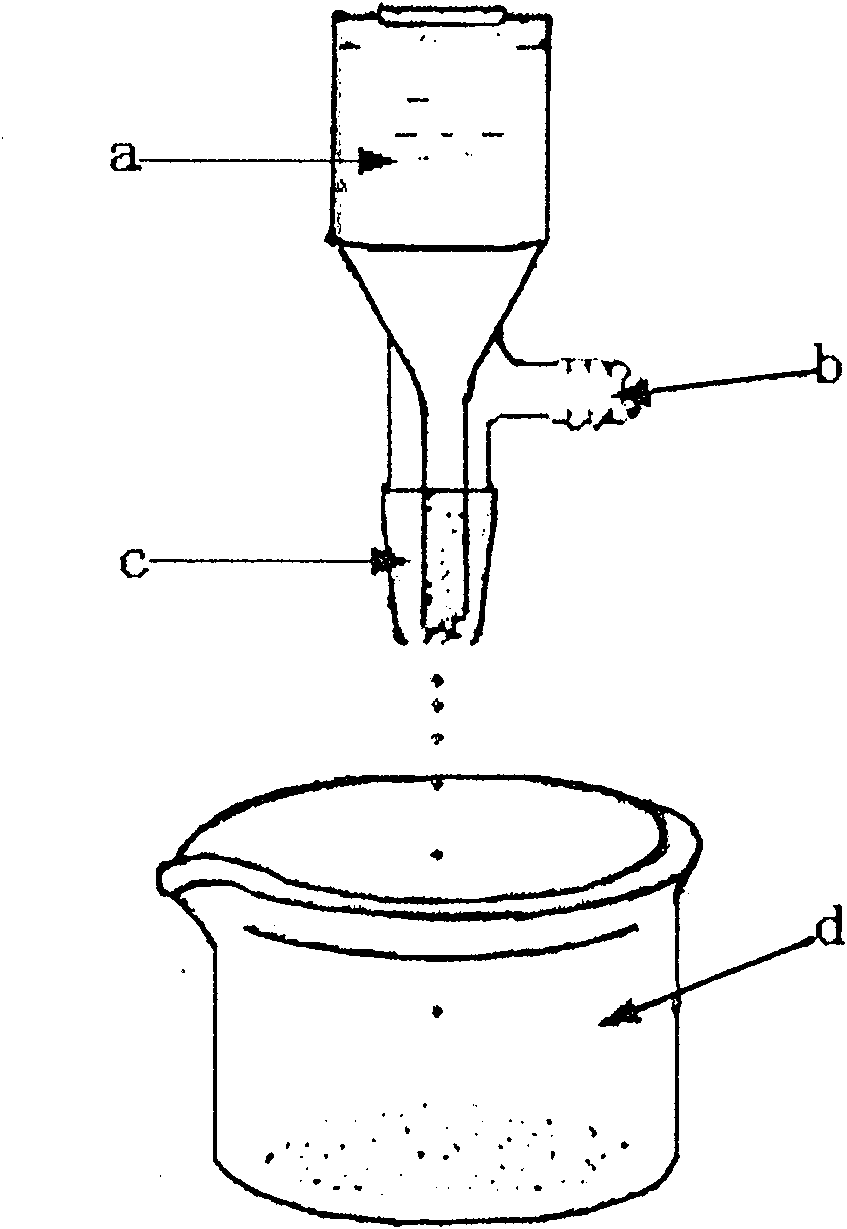Freeze forming preparation process of ternary lithium ceramic microphere
A technology of ceramic microspheres and freeze molding, which is applied in ceramic products, applications, household appliances, etc., can solve the problems of insufficient internal pore structure, difficulty in high density of lithium ceramic microspheres, and poor sphericity of ceramic microspheres. Controllable particle size of microspheres, good internal pore structure, and low cost
- Summary
- Abstract
- Description
- Claims
- Application Information
AI Technical Summary
Problems solved by technology
Method used
Image
Examples
Embodiment 1
[0032] (1) Dissolve 4g of polyvinyl alcohol completely in 96g of distilled water and let it stand for use; (2) Weigh 150g of the mixture of lithium carbonate and silicon dioxide according to the metering ratio, and add it to (1) the prepared polyvinyl alcohol solution , Grind on a planetary grinder for 3 hours to form a stable suspension slurry; (3) Transfer the suspension slurry to a container with a nozzle, open the pressure control system, and control the pressure at 40kPa, and the slurry from the nozzle Sprayed out and dropped into a container with liquid nitrogen at the bottom to form a precursor of ceramic microspheres; (4) Transfer the precursor of ceramic microspheres to an enamel tray, put it in a cold dryer and freeze-dry for 12 hours at a temperature of -30℃; (5) Put the dried microspheres obtained by the treatment in (4) into a high-temperature sintering furnace, and carry out program heating treatment, 120℃ for 24h, then 500℃ for 36h, and then heated to 1000℃ for 20h ...
Embodiment 2
[0034] (1) Dissolve 2g of polyvinyl alcohol in 98g of distilled water until it is transparent, and set it aside; (2) Weigh 150g of the mixture of lithium nitrate and silica according to the metering ratio, add it to (1), and grind on a planetary grinder. After hours, a stable suspension is obtained; (3) Pour the suspension into a container with a nozzle, turn on the pressure control system, and control the pressure at 40kPa. Small droplets are ejected from the nozzle and fall to the bottom with liquid nitrogen. In the container, the formed ceramic microsphere precursor; (4) Transfer the ceramic microsphere precursor to an enamel tray, and freeze-dry it in a freeze dryer for 8 hours at a temperature of -30°C; (5) Transfer the ceramic microsphere precursor to (4) The dried microspheres obtained by the treatment are put into a high-temperature sintering furnace, and the program is heated, 120°C for 24h, 400°C for 48h, then heated to 1050°C for 24h, and then heated to 1150°C for 4h. T...
Embodiment 3
[0036] (1) Dissolve 5g of polyvinyl alcohol in 95g of ethanol and let it stand for use; (2) Weigh 150g of a mixture of lithium carbonate and titanium dioxide according to the metering ratio, add it to (1), and grind on a planetary grinder for 2 hours, Obtain a stable suspension slurry; (3) Transfer the suspension slurry to a container with a nozzle, turn on the pressure control system, and control the pressure at 70kPa. The droplets are ejected from the nozzle mouth and become spherical due to surface tension. , Drip to the bottom of the ethylene glycol liquid nitrogen mixture to form a ceramic microsphere precursor; (4) Transfer the microsphere precursor to an enamel tray, put it in a freeze dryer and freeze-dry for 10 hours, the freezing temperature is- 20℃; (5) Put the dried microspheres obtained by the treatment of (4) into a high-temperature sintering furnace, and carry out program heating treatment, 150℃ for 24h, 700℃ for 18h, and then heated to 1100℃ for 12h, continue heati...
PUM
| Property | Measurement | Unit |
|---|---|---|
| diameter | aaaaa | aaaaa |
Abstract
Description
Claims
Application Information
 Login to View More
Login to View More - R&D
- Intellectual Property
- Life Sciences
- Materials
- Tech Scout
- Unparalleled Data Quality
- Higher Quality Content
- 60% Fewer Hallucinations
Browse by: Latest US Patents, China's latest patents, Technical Efficacy Thesaurus, Application Domain, Technology Topic, Popular Technical Reports.
© 2025 PatSnap. All rights reserved.Legal|Privacy policy|Modern Slavery Act Transparency Statement|Sitemap|About US| Contact US: help@patsnap.com

